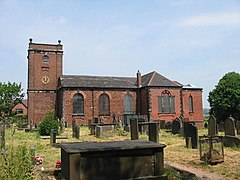Norton le Moors
| Norton le Moors | |
|---|---|
 St Bartholomew's Church, Norton le Moors |
|
| Norton le Moors shown within Staffordshire | |
| Population | 11,157 |
| OS grid reference | SJ8907751462 |
| District | |
| Shire county | |
| Region | |
| Country | England |
| Sovereign state | United Kingdom |
| Postcode district | ST6 |
| Police | Staffordshire |
| Fire | Staffordshire |
| Ambulance | West Midlands |
| EU Parliament | West Midlands |
| UK Parliament | |
The ecclesiastical parish of Norton le Moors is located in the north-east of the city of Stoke-On-Trent, in the county of Staffordshire. The majority of the parish is in the city however some lies in the Staffordshire Moorlands district. Approximately 3.4 miles (5.5 km) north of Hanley, one of six major towns that joined together to form the city of Stoke-on-Trent in 1910. Norton le Moors borders Ball Green in the north, Stockton Brook in the east, Milton in the south, and Bradeley in the west, making it one of a number of small villages in the Stoke area.
The civil parish of Norton le Moors was established in 1837 until it was abolished in 1965 and incorporated into the parishes of Bagnall, Brown Edge and Stoke-on-Trent. Two years later Norton Parish Council obtained permission to change its name to Brown Edge Parish Council. Norton le Moors appears in the Domesday Book of 1086 as Nortone, meaning North town. At the time of the Domesday Survey the village was held by Robert de Stafford. During the Middle Ages the area developed due to its location on the road from Leek to Burslem, later turned turnpiked as the Leek to Newcastle road.
In 2001, the population for the ward of Norton and Bradeley stood at 11,157. However, the population for Norton le Moors itself has significantly changed over time. The UK national census revealed that in 1801 the total population for the parish was 1,480 and up until 1891 the population continued to increase. In 1901 the population of the parish had dropped from 9,919 in 1891 to 4,600, a drop of 5,319 people. The population started to increase again for the next 20 years until there was a decline in 1931. Since then the population has been steadily increasing.
...
Wikipedia

